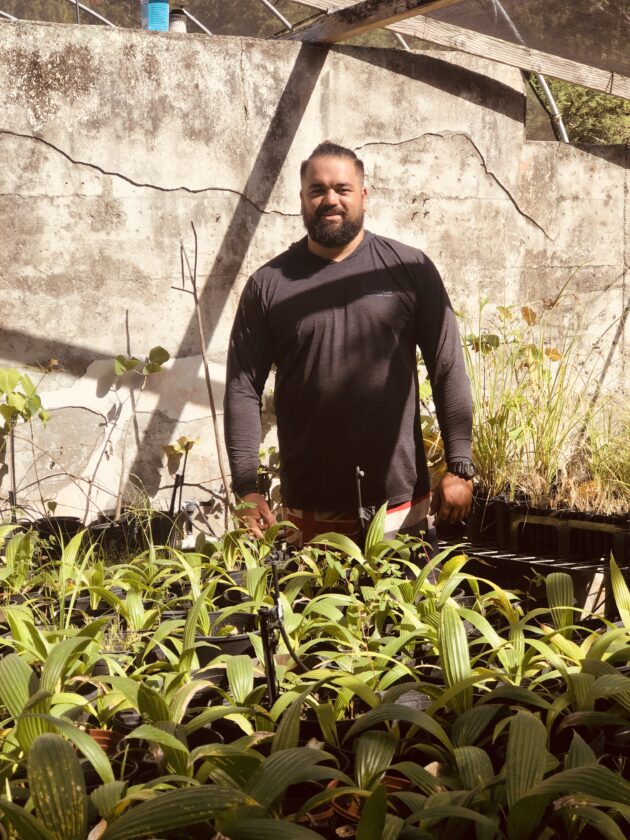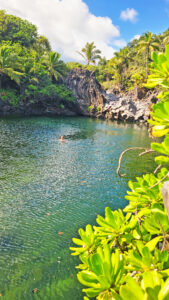Bill intends to help nonprofits grow native plants

Hawaii Land Trust official Kia`i Collier manages the Waihee Refuge where workers raise native species of plants, including Loulu palms. The county is proposing to develop a water preservation rate that would help nonprofit native growers. Maui News photo/Gary Kubota
The Maui County Council is considering a bill that creates a preservation water rate for nonprofit growers of native plants.
Supported by county water director John Stufflebean, Bill 56 was recommended for first reading by the County Council’s Water and Infrastructure Committee.
Stufflebean said the idea of establishing a preservation rate came after two nonprofits asked to grow native plants at agricultural water rates but were turned down because they didn’t fit the profile of commercial agricultural users.
Both nonprofit trusts, the Hawai’i Land Trust and Waiohuli Mana Foundation, are being charged the general consumer rate of $7.58 per 1,000 gallons, and the preservation rate for fiscal year 2025 is supposed to be $4.63 per 1,000 gallons, according to the department.
Waiohuli Mana Foundation official David Chevalier said he hasn’t seen the details of the proposal, but he’s encouraged the water department is working to lower water rates for nonprofits raising native plants.
Chevalier said the Foundation has eight residential lots in Waiohului dedicated to restoring native forests.
“It’s just purely a naive reforestation effort,” said Chevalier, a retiree who once owned Blue Hawaiian Helicopters. “We’re trying to bring the native birds back. That’s what we hope.”
He said the foundation is planting a number of native plants including 500 koa trees.
Native plants and animals play a key role in creating the watersheds for Haleakala and the West Maui Mountains where dyke-confined rainwater percolates to provide millions of gallons of ground water a day.
The Maui County Department of Water Supply said expanding the growing native plants will not only help local entities but is expected to provide more options and variety to people who want to use less water-intensive native plants.
According to the department, the bill would benefit the county by increasing the efficiency of the hydrologic process in the watersheds. The restoration of native plants and trees could also have downstream benefits by helping to reduce flooding and erosion.
The department said one native Hawaiian nursery has native trees such as Iliʻahi, Ohe Makai, koa and Ohia — plants that are in high demand but limited in supply because they take some time to germinate and grow under the right conditions.

The rare native Ohai plant grows at the Waihee Refuges operated by the Hawai’i Land Trust, where the focus is on encouraging the growth of native Hawaiian plants.
Hawai’i Land Trust official Kia’i Collier said he’s been talking with the county water officials about a way to lower their water rates for growing native plants including naupaka, milo, hala, and `a`alii.
Refuge in Central Maui and the 81-acre Nu`u Refuge in southeast Maui.
The 277 acres in Waihee has some rare native plants including Ohai.
Collier said the Hawai’i Land Trust has been growing Loulu palms in the nursery to plant in the refuges because of its importance as a foundation for biodiversity.
“It’s difficult to find a grove of Loulu that has been in abundance that can be used for cultural practices,” said Collier, the manager of the Waihee Refuge. “But it’s making a comeback.”
Loulu is used in weaving and constructing traditional Hawaiian houses.
Trust workers have planted 500 Loulu and are raising another crop of 500.
“That’s why we really need the nursery,” he said.
He said the trust was paying the agricultural rate but was informed by the county water department that it didn’t qualify for it and has been waiting to have more discussions on getting the agricultural rates.
He said he hasn’t seen the water department’s proposed bill before the council but would support it if it was cost-effective and would help the trust in its activities.
Correction: The Hawai’i Land Trust was misidentified in an earlier version of this report.





